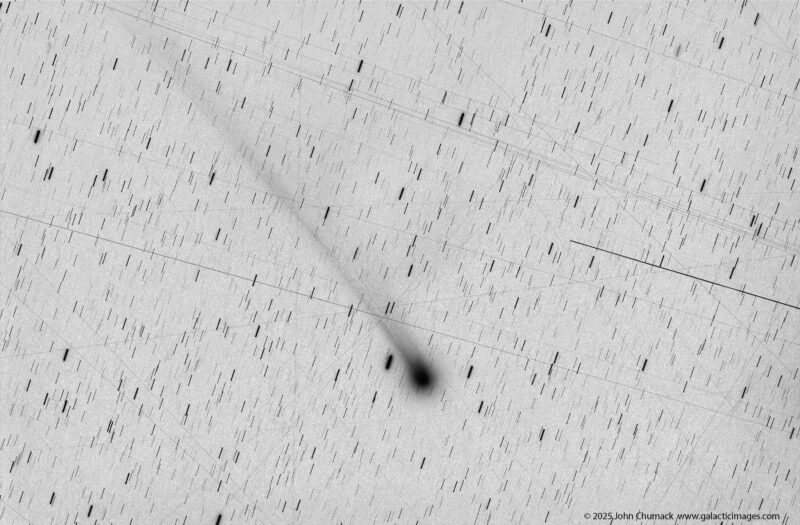Watch from multiple locations as a Starlink satellite reenters Earth’s atmosphere, burning up over California, on September 25, 2025. Currently, there are 1 to 2 Starlink satellites falling back to Earth each day. Soon there will be more.
Starlink satellites are falling
It might not be long before you look up and see a fiery, slow-moving object streaking across your night sky and, clearly, breaking into pieces. That’s if you haven’t seen such a thing already. There are currently one to two Starlink satellites falling back to Earth every day, according to retired Harvard astrophysicist Jonathan McDowell. His acclaimed website Jonathan’s Space Report is widely regarded as the definitive source on spacecraft that go up … and come down. When we asked him about the deluge of Starlink satellite breakups that have recently been flooding social media, he pointed us to his graph showing Starlink reentries over time.
There are more than 8,000 Starlink satellites overhead at this moment. They’re a product of the space transportation company SpaceX. And that number is growing. Plus there are other companies and countries also deploying more and more satellites, adding to the number of satellites in Earth orbit. Many of these are in low-Earth orbits, which extend up to an altitude of 1,200 miles (2,000 km) above our planet. And the lifespan of low-Earth orbit satellites, such as Starlink, is only about 5 to 7 years. Soon, McDowell told us, there will be up to 5 satellite reentries per day. He said:
With all constellations deployed, we expect about 30,000 low-Earth orbit satellites (Starlink, Amazon Kuiper, others) and perhaps another 20,000 satellites at 1,000 km [620 miles] from the Chinese systems. For the low-orbit satellites we expect a 5-year replacement cycle, and that translates to 5 reentries a day. It’s not clear if the Chinese will orbit-lower theirs or just accelerate us to chain-reaction Kessler syndrome.
The Kessler syndrome is a scenario in which the density of objects in low-Earth orbit is high enough that collisions between objects cause a cascade, with each collision generating space debris that increases the likelihood of further collisions. Read more about the Kessler syndrome here.
Watch our interviews with Jonathan McDowell:
Space junk and other human-made space hazards
The truth about Near-Earth Collisions
Catch a falling SpaceX Starlink
How to tell the difference between space junk and meteors
In many of the images online showing the fiery disintegration of something in our atmosphere, a photographer is asking:
What did I just see?
So, is there a quick way to tell the difference between a meteor and space junk burning up overhead? McDowell explained:
The easy ‘meteor vs. space junk’ discriminator is speed. A meteor from solar orbit, even a big fireball, lasts only a few seconds and is gone, whizzz. Space junk goes more like airplane angular speed (really faster than a plane, but higher so it cancels out) and may be overhead for a couple of minutes.
Watch a Russian rocket reenter Earth’s atmosphere over southeastern Australia in May 2020.
How solar activity affects Starlink satellites and others
As SpaceX launches more and more Starlink satellites, more of them also come falling back to Earth. But they don’t all fall out of orbit for the same reason. Besides the fact that some of them are at the end of their lifespans, there are other reasons satellites can reenter.
For example, high solar activity can shorten the lifespan of satellites, and we’re just past a solar maximum and still in the period of high solar activity. Solar storms heat Earth’s upper atmosphere, causing it to “puff up.” The result is an increase in atmospheric drag: low-Earth orbit satellites like Starlink (and ISS, and Earth-observing satellites) find themselves flying through thicker air than usual. That extra air density creates aerodynamic drag, which slows the satellites down and causes them to lose altitude.
Operators might be able to boost some satellites back up. But, if they can’t, the satellites can reenter the atmosphere prematurely. That’s what happened in early 2022, when a solar storm doomed 40 recently launched Starlink satellites.
Also, malfunctions can occur
Solar activity isn’t the only thing that brings satellites down. Malfunctions can occur. For example, on July 12, 2024, a Falcon 9 rocket failed during the second stage, leaving 20 Starlink satellites in the “wrong” orbit. In that case, McDowell said:
All but two of the satellites reentered on the day of launch, and the last one reentered on July 20, eight days after launch.
Recent Starlink satellites reentries shared on social media
Here’s a sample of some of the recent Starlink satellite reentries that people have witnessed. Keep in mind that many of the reentries are not being witnessed. That’s because some 70% of Earth’s surface is water, so in many places the reentries happen overhead where no one is around to see them. Also, reentries that happen in the middle of the night or during bright daylight are less likely to be witnessed.
September 25, 2025: A Starlink satellite lit up the sky over the Bay Area in California.
WATCH: Starlink debris seen over the skies of Sacramento County, California.
A reentry observed over California at 0245 UTC Sep 26 (7.45pm PDT Thu Sep 25) is consistent with Starlink 1586.
— Jonathan McDowell (@planet4589.bsky.social) 2025-09-26T23:51:48.535Z
September 22, 2025: A Starlink satellite burned up over Saskatchewan, Canada.
Here’s the official Global Meteor Network camera video from Lucky Lake, Saskatchewan! This video is courtesy University of Western Ontario and Defence R&D Canada.I counted 13 pieces in the video, how many do we think made it to the ground and are sitting on canola stubble east of Saskatoon?
— Prof. Sam Lawler (@sundogplanets.mastodon.social.ap.brid.gy) 2025-09-26T15:52:56.000Z
Starlink 1066 reentered over Canada at about 0600 UTC Sep 23.
— Jonathan McDowell (@planet4589.bsky.social) 2025-09-23T23:39:15.840Z
September 21, 2025: This Starlink reentry created a stir when it burned up over Texas.
@hearts4hoovestherapy Well that was cool! #Hearts4Hooves #fyppppppppppppppppppppppp #goviral #foryoupage #fyp?
Starlink 1636, launched in Aug 2020, reentered over Texas last night (Sep 22 0130 UTC / Sep 21 8.30pm CDT) and was observed widely.
— Jonathan McDowell (@planet4589.bsky.social) 2025-09-23T00:27:13.160Z
What effect do the disintegrating satellites have on Earth’s atmosphere?
In 2023, the National Oceanic and Atmospheric Administration (NOAA) shared a scientific investigation of Earth’s stratosphere. The stratosphere is the layer of atmosphere more than 7 miles (11 km) above Earth’s surface, where jet planes fly and the ozone layer exists. NOAA said the stratosphere:
… contains an unexpected quantity of particles with a variety of exotic metals. The scientists believe the particles come from satellites and spent rocket boosters as they are vaporized by the intense heat of reentry.
The researchers found particles containing the rare elements niobium and hafnium. They also found a significant number of particles contained copper, lithium and aluminum at concentrations far exceeding the abundance found in space dust. The use of these elements in heat-resistant, high-performance alloys pointed at the spaceflight industry as the culprit.
These tiny particles could absorb and reflect the sun’s rays. They could also serve as surfaces for ozone-destroying chemical reactions. And these particles could change our planet’s atmosphere in ways we still don’t fully understand. Research in this area is ongoing.

Bottom line: There are now one to two Starlink satellites falling back to Earth each day, burning up in the atmosphere with consequences not fully understood.

